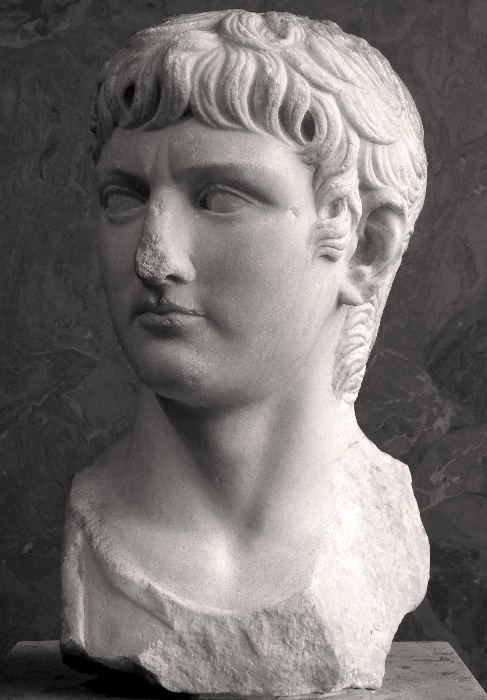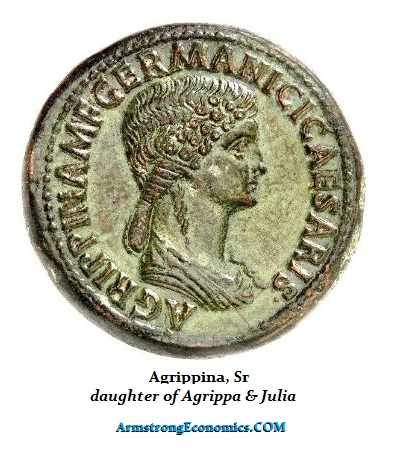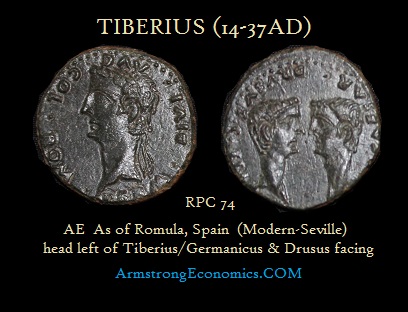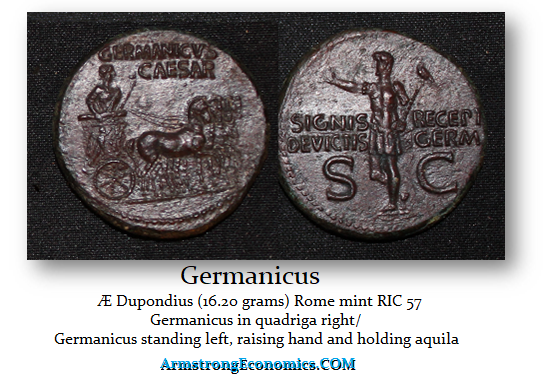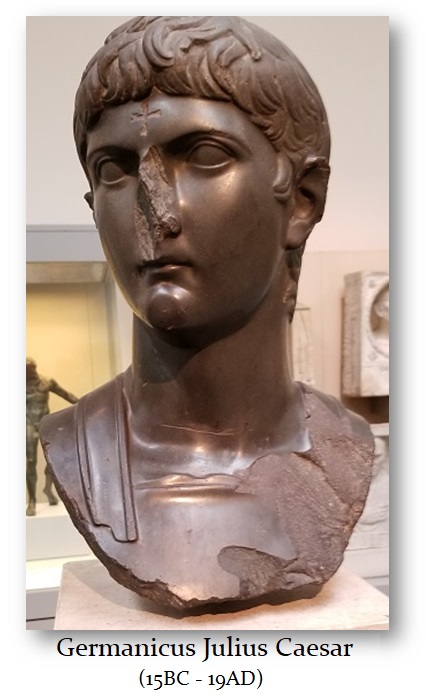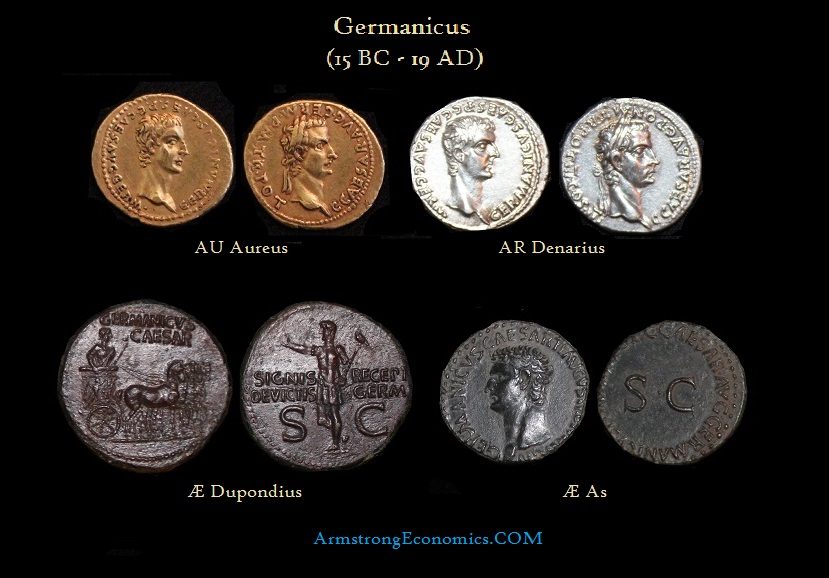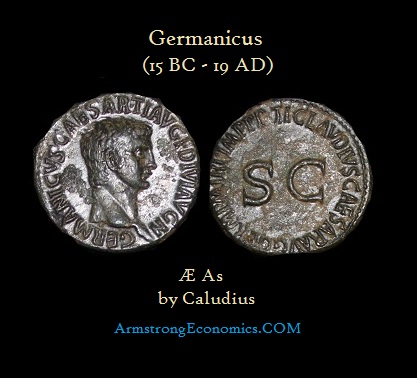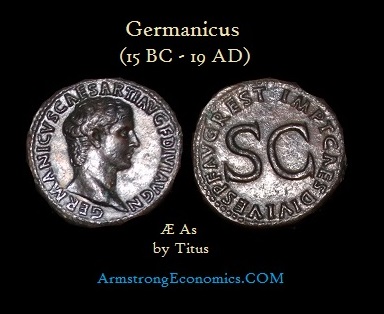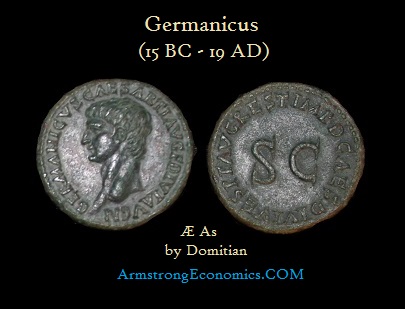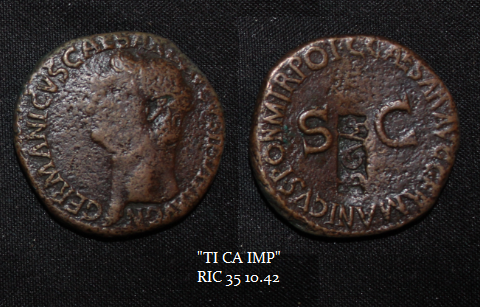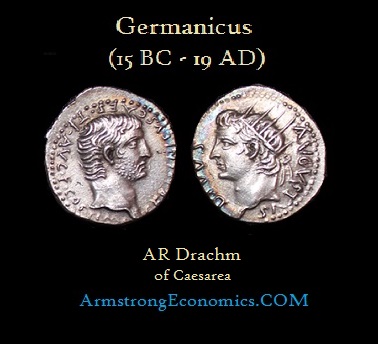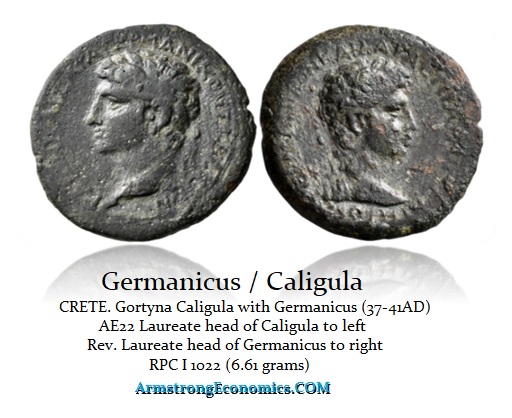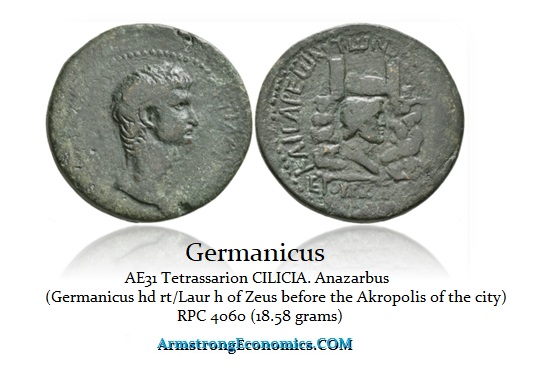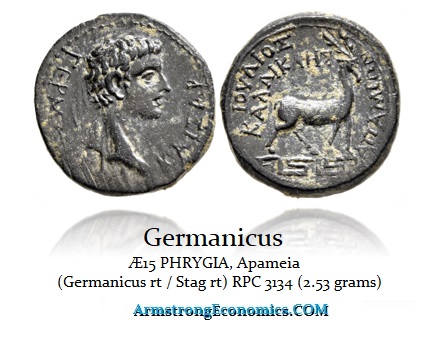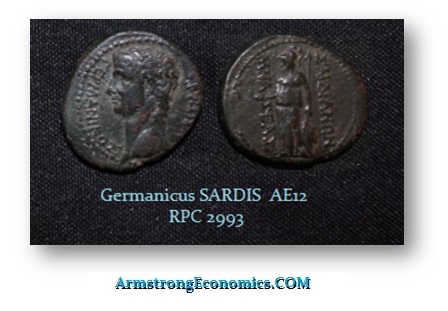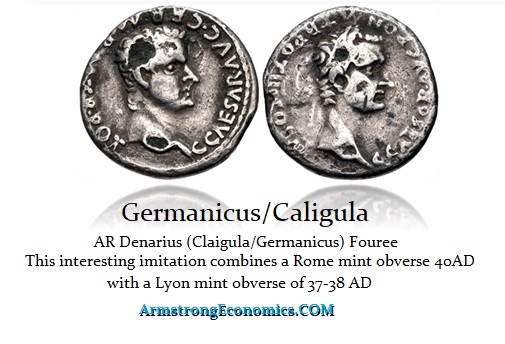Germanicus
15 BC – 19 AD
Grandson of Marc Antony
Son of Antonia
Brother of Emperor Claudius
Father of Emperor Caligula
Germanicus was the elder son of Nero Claudius Drusus and Antonia, representing the first potential heir from the combined Julio-Claudian bloodline. Germanicus was born in 15 BC and was adopted by Tiberius in 4 AD when Augustus adopted him as his ultimate heir.
Germanicus possessed all the highest qualities of body and mind, to a degree never equaled by anyone. A handsome person, unequaled valor, surpassing ability in the oration of Greece and Rome, unexampled kindliness, and a remarkable desire and capacity for winning men’s regard and inspiring their affection.
Suetonius Life of Caligula Ill
Suetonius portrays an image of Germanicus which is beyond probability. The reality of Germanicus was much less perfect, but given the emotional tide of the period, the favoritism history has shown toward Germanicus is understandable. We must remember that Augustus ruled as Emperor for nearly 41 years. This is certainly time enough for the generations to come and go. Therefore, the rule of Augustus was similar to the first 40 years following World War II, where peace prevailed for the most part and prosperity filled the land. In this context, the young Germanicus appeared very much to the people, as did John F. Kennedy in modern times. And like Kennedy, who became more perfect after his assassination, so did Germanicus in his time period. If we look beyond the legend and into the history of the man, we see very much a dashing young politician who perhaps represented to the people the dawn of a new generation.
Germanicus was married around 8 BC to Agrippina, the daughter of Agrippa and Julia. Agrippina was a very outspoken woman who accompanied her husband on all his campaigns and bore him five sons and three daughters, one of who would become the future Emperor Caligula. Their daughter, Agrippina Junior, became the mother of the future Emperor Nero.
When Tiberius came to power, he emphasized his heirs being Germanicus and his son Drusus as illustrated above. Both Drusus and Germanicus played important roles in securing support for Tiberius following the death of Augustus.
Drusus was sent to settle the unrest among the legions in Pannomia, while Germanicus’ first major role in history was to suppress the mutiny of the Rhine legions. Tacitus claims that the soldiers offered to make him Emperor instead of Tiberius, but the troops merely wanted higher pay and better conditions. Germanicus was not able to solve the problem. However, he had taken his wife Agrippina the Elder and their family along with him to the frontier. Germanicus forced his wife to leave with the children when the situation became dangerous. Her departure so shamed the mutineers that the revolt quickly subsided. It was actually during this campaign that the future Emperor Caligula was born.
Germanicus’ popularity was indeed very much enhanced by his wife’s actions. During another campaign against the Chatti and Germanic tribes, Agrippina worked personally to prevent panic from spreading among the legions stationed in the encampment on the Rhine. She worked distributing food and clothing among the inhabitants and gained much popularity among the Roman people for her actions.
Germanicus remained with the Rhine legions between 14 and 16 AD. He did lead the legions deep into Germany in successive campaigns and managed to recover two of the three legionary standards lost at the Teutonburg Forest by Quintillius Varus. This bronze dupondius commemorates the recovery of the legionary standards. Germanicus also buried the remains of whatever Roman dead he encountered. In reality, Germanicus was, at best, a moderately competent general, but his second campaign into Germany nearly ended in disaster.
Tiberius recalled Germanicus to Rome and gave him a splendid triumph on May 26th, 17 AD. This was perhaps more of a propaganda event for Tiberius to win popular support. However, during this period, the emotional support for Germanicus became quite noticeable in Rome, which caused some concern in court.
Perhaps by the design of Livia, Tiberius’ scheming mother, Germanicus was ordered to the East in an attempt to remove him from Rome. Tiberius also appointed Germanicus, his colleague, as consul in 18 AD, which marked Germanicus as the chosen successor. Germanicus departed Rome for the East shortly after his triumph in 17 AD. While at Antioch in Syria, Germanicus came into conflict with Gnaeus Piso, the new governor of Syria and a friend of Tiberius. Germanicus overstepped his authority by visiting Egypt without imperial permission. When Germanicus became ill and died at Antioch on October 10th, 19 AD, his wife Agrippina insisted that Piso had poisoned him. Agrippina marched to Rome and held a funeral procession for Germanicus, and openly accused both Livia and Tiberius of ordering his murder. Tiberius was forced to put his friend Piso on trial. In the end, Piso was compelled to commit suicide, but Agrippina ensured that suspicion toward Tiberius would never disappear.
Monetary System
Black Basault Bust from the Caesarean Temple in Alexandria, Egypt
Note: All the coins bearing his name and portrait were struck about twenty years and more after his death.
Mints: Rome, Caesarea
Obverse Legends:
GERMANICVS CAESAR
GERMANICVS CAESAR TI AVGVST F DIVI AVG N
GERMANICVS CAES PC CAES AVG GERM
DENOMINATIONS
Issued by Caligula
AU Aureus with Caligula (6.54 grams)
AR Denarius with Caligula (3.54 grams)
Æ Dupondius
Æ As bare head left (12 grams)
Issued by Claudius
Æ As bare head right (12 grams)
Restitution of Titus
Æ As bare head right (12 grams)
Æ As bare head left (12 grams)
Restitution of Domitian
Æ As bare head left (12 grams)
COUNTERSTAMPS
Æ Dupondius TI (ΛV) in rectangular countermark Pangerl 54.
Æ As (Counterstamped “TI CA IMP”)
Æ As (Counterstamped (TIB) C(LA) (IMP) in a rectangular Pangerl 51)
Colonial Coinage
Caesarea
AR Drachm with Augustus Radiate (3.21 grams) RIC 61
CRETE
AE22 CRETE Knossos (hd rt/Caligula hd rt) RPC 994
AE22 CRETE Knossos (hd rt/Caligula hd rt) RPC 995
Æ23 CRETE, Cnossus. (Caligula r/Germanicus r) RPC 996
Æ23 CRETE, Cnossus. (Caligula r/Germanicus r) RPC 999
AE22 CRETE. Caligula/Germanicus Laur hd right RPC 1022
CILICIA
AE31 Tetrassarion CILICIA. Anazarbus (hd rt/Laur h of Zeus before the Akropolis of the city) RPC 4060
PHRYGIA
Æ15 PHRYGIA, Apameia (Germanicus rt Stag rt) RPC 3134
AE12 Sardes (Bare hd lf) RPC 2993 (3.31 grams)
CONTEMPORARY COUNTERFEIT
AR Denarius (Claigula/Germanicus) Fouree (2.71 grams)
This interesting imitation combines a Rome mint obverse of AD 40 and a Lyon mint obverse of AD 37-38

